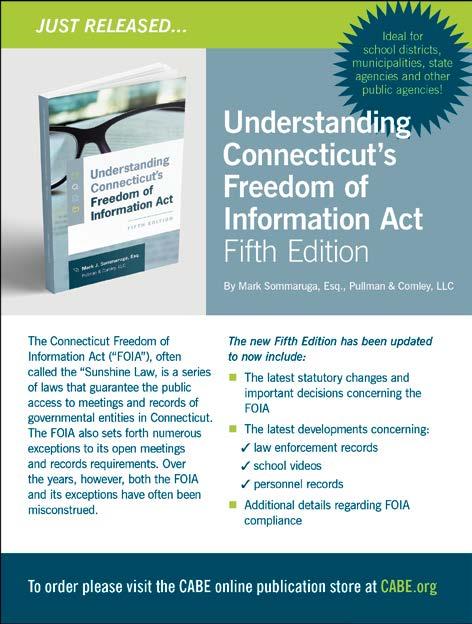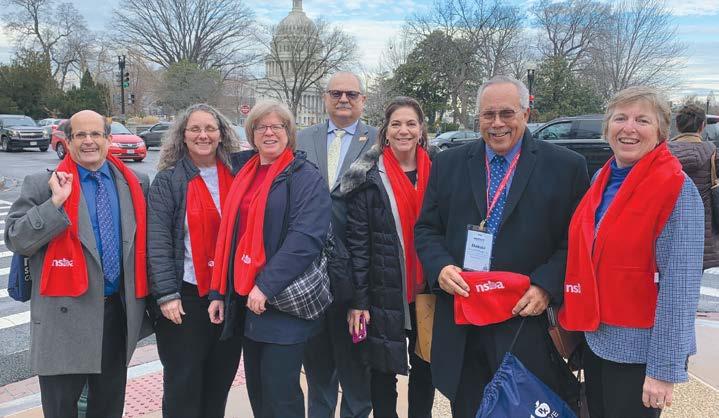
5 minute read
Let others shine, whether other Board members or Staff. Dale Carnegie told us “a person’s name is to that person, the sweetest and most important sound in any language”. Almost everyone likes to see their names in print in a positive way, too
THE POLICY CORNER Vincent A. Mustaro Senior Staff Associate for Policy Service, CABE
Policy Support for Social and Emotional Learning (SEL), Part II Editor’s Note: Part I of this article appeared in the February, 2020 CABE Journal. Student Input Needed
Advertisement
Authentic student voice is when students are given an opportunity to participate in decisions that affect their education and school experiences. Student input can be a powerful tool for building a safe and welcoming school environment. Efforts to gather students’ insights and use them to inform decision-making sends an important message to young people and encourages them to be more engaged in their schooling.
The most effective student voice initiatives are inclusive and ensure that the students who are heard from are not limited to the usual academic high flyers or student leaders. Schools should identify and bring in students from different academic levels, races and backgrounds when soliciting input.
To help staff buy-in for elevating student voice, superintendents can take the lead in setting and communicating the expectation that all adults will take feedback from students seriously. The Student-Teacher Relationship and Empathy
Studies have shown that teachers who build relationships of empathy and respect with their students results in a strong positive effect on how children feel about school and how hard they are willing to work in class. Emerging research suggests some small changes can create a healthier, more productive learning environment and lessen behavior issues.
Regretfully, insufficient professional development has been provided to assist staff in determining students’ emotional states as well as their academic status. Time is necessary to connect with and to learn enough about each student. Teachers need assistance in managing that need. The Implementation of Social Emotional Learning at School
The core competencies of SEL can be taught in many ways and across settings. The ultimate goal is to teach students to understand and respect themselves and others.
Explicit instruction can be used to outline learning goals for SEL-specific activities and explain the SEL skills to students. However, social-emotional learning can happen in more than just a lesson a day. Opportunities can be provided to practice these skills in a class or content area.
Making SEL a part of the school culture, across all classrooms and throughout the day is part of a school wide efforts to improve student well-being. A school wide emphasis is often implemented as part of positive behavioral interventions and supports. Different approaches can be used in the schools. There are some evidence-based approaches to SEL. These include Responsive Classroom, Open Circle and RULER. RULER stands for recognizing, understanding, labeling, expressing and regulating emotion. These approaches help both in the classroom and in school wide efforts that involve students’ families.
SEL can help improve the overall quality and character of school life and improve the school climate. SEL skills can be woven in traditional lesson plans, at all grade levels. While best to start at a young age, the key is to start where the students are. Some students may need targeted supports to fully benefit from SEL.
Consider the following, developed by the Wisconsin Department of Public Education, when implementing SEL in classrooms, schools and districts: 1. Make SEL a priority. 2. Integrate SEL into academic instruction. 3. Create an environment that supports SEL. 4. Provide training and supports for SEL programs and practices. 5. Coordinate efforts to support all systems. 6. Use data to assess progress. 7. Focus on equity. 8. Incorporate student voice. 9. Involve parents and communities. Status of SEL in Connecticut
Public Act 19-166, “An Act Concerning School Climates,” established a Social and Emotional Learning and School Climate Advisory Collaborative. CABE and CAPSS are represented on the collaborative committee. The advisory collaborative has been given a number of important tasks, the completion of which will greatly assist local districts in the implementation of SEL and improvement of school climate.
This legislation also provided new definitions for “school climate, “positive school climate,” “social and emotional learning,” and “emotional intelligence,” which have been made a part of the policy pertaining to bullying and safe school climate. Policy Implications
This topic impacts many existing policy areas. They include, but are not limited to, policies pertaining to nondiscrimination, staff development, discipline, bullying, safe school climate, cyberbullying, child abuse and neglect, suicide prevention, harassment, civility, school safety, student wellness and supportive services. The number gives testimony to district efforts to provide a safe and nurturing school climate conducive to student well-being, instruction and learning. These policy topics are under the umbrella of school climate. SEL is essential to creating schools that effectively prepare all students to succeed in school and in life. Systemic whole school implementation of SEL encourages safe, supportive school communities in which all young people are valued. When a school’s culture is based on student strengths, providing tiered supports as needed, all students in the school community can benefit. How we teach is as important as what is taught. The development of social and emotional competencies in all students is complex work. Therefore, the necessary approach involves direct instruction through curriculum efforts and through the various programs and services a school district offers.
Much is available in the professional literature and research pertaining to SEL programs to assist local districts. Sufficient resources, community involvement and staff training are essential requirements.
A new policy, #6142.102 “Social and Emotional Learning” provides board of education guidance pertaining to the implementation of social and emotional learning in schools. It is available upon request. Leonard Lockhart was named CABE Diversity Committee Chair by President Donald Harris. The Committee’s charge is to: A. Work to ensure that there is diversity (in particular, people of color) and sensitivity to diversity in all of CABE’s work. B. Encourage boards of education, school and district leaders, as well as State Government to continue to consider the importance of diversity and multiculturalism in public education. The Committee recently released an Equity Toolkit, thanks to funding from the Nellie Mae Foundation and the Graustein Memorial Fund. The Toolkit provides information to Boards about developing policies and practices that ensure equity and excellence in their districts. Lockhart Named CABE Diversity Committee Chair Leonard Lockhart









